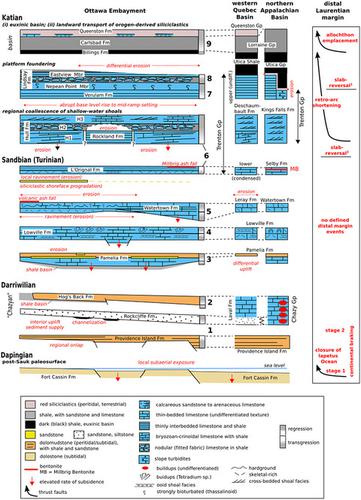当前位置:
X-MOL 学术
›
Basin Res.
›
论文详情
Our official English website, www.x-mol.net, welcomes your
feedback! (Note: you will need to create a separate account there.)
Sequence stratigraphy of a Middle to Upper Ordovician foreland succession (Ottawa Embayment, central Canada): Evidence for tectonic control on sequence architecture along southern Laurentia
Basin Research ( IF 2.8 ) Pub Date : 2020-07-26 , DOI: 10.1111/bre.12495 Nkechi E. Oruche 1 , George R. Dix 1
Basin Research ( IF 2.8 ) Pub Date : 2020-07-26 , DOI: 10.1111/bre.12495 Nkechi E. Oruche 1 , George R. Dix 1
Affiliation

|
The Middle to Upper Ordovician foreland succession of the Ottawa Embayment in central Canada is divided into nine transgressive‐regressive sequences that defines net deepening of a platform succession over ~15 m.y. from peritidal to outer ramp settings, then a return to peritidal conditions over ~3 m.y. related to basin filling by orogen‐derived siliciclastics. With a backdrop of net eustatic rise through the Middle to Late Ordovician, there are several different expressions of structural influence on sequence development in the embayment. During the Middle Ordovician (Darriwilian), foreland‐basin initiation was marked by regional onlap with abundant synsedimentary deformation across a faulted trailing‐margin platform interior; subsequent craton‐interior uplift resulted in voluminous influx of siliciclastics contemporary with local structurally influenced local channelization; then, a formation of a platform‐interior shale basin defines continued intrabasin tectonism. During the Late Ordovician (Sandbian, early Katian), structural influence was superimposed on sea‐level rise as indicated by renewed local development of a platform‐interior shale basin; differential subsidence and thickness variation of platform carbonate successions; abrupt deepening across shallow‐water shoal facies; and, micrograben development coincident with foreland‐platform drowning. These stratigraphic patterns are far‐field expressions of distal orogen development amplified in the platform interior through basement reactivation along an inherited buried Precambrian fault system. Comparison of Upper Ordovician (Sandbian‐lower Katian) sequence stratigraphy in the Ottawa Embayment with eustatic frameworks defined for the Appalachian Basin reveals greater regional variation associated with Sandbian sequences compared to regional commonality in base level through the early Katian.
中文翻译:

中至上奥陶纪前陆演替层序地层(渥太华使馆,加拿大中部):对南部劳伦西亚沿层序构造进行构造控制的证据
加拿大中部渥太华河口的奥陶纪中陆到上陆前陆演替分为9个海侵-渐进序列,定义了从蠕动到外斜坡的超过15my的平台演替的净加深,然后是〜3的回到蠕动状态与造山型硅质碎屑岩充填盆地有关。在整个奥陶纪中晚期到晚期都出现净欣快上升的背景下,该构造对嵌套层序发育的影响有几种不同的表达方式。在中奥陶纪(Darriwilian)期间,前陆盆地起伏的特征是区域性交叠,在断层后缘台地内部形成了丰富的同沉积变形。随后的克拉通向内隆起导致大量的当代硅质碎屑涌入,并受到局部结构性影响的局部通道化;然后,平台内页岩盆地的形成定义了持续的盆地内构造。在奥陶纪晚期(桑德时期,加迪安早期),结构性影响叠加在海平面上升上,这表现为平台内页岩盆地的局部更新发展。平台碳酸盐岩演替的差异沉降和厚度变化;浅水浅滩相突然加深;以及与前陆平台溺水相吻合的微草生长。这些地层学模式是远古造山带发育的远场表达,通过沿继承的地下前寒武纪断层系统的基底再活化,在平台内部放大了。
更新日期:2020-07-26
中文翻译:

中至上奥陶纪前陆演替层序地层(渥太华使馆,加拿大中部):对南部劳伦西亚沿层序构造进行构造控制的证据
加拿大中部渥太华河口的奥陶纪中陆到上陆前陆演替分为9个海侵-渐进序列,定义了从蠕动到外斜坡的超过15my的平台演替的净加深,然后是〜3的回到蠕动状态与造山型硅质碎屑岩充填盆地有关。在整个奥陶纪中晚期到晚期都出现净欣快上升的背景下,该构造对嵌套层序发育的影响有几种不同的表达方式。在中奥陶纪(Darriwilian)期间,前陆盆地起伏的特征是区域性交叠,在断层后缘台地内部形成了丰富的同沉积变形。随后的克拉通向内隆起导致大量的当代硅质碎屑涌入,并受到局部结构性影响的局部通道化;然后,平台内页岩盆地的形成定义了持续的盆地内构造。在奥陶纪晚期(桑德时期,加迪安早期),结构性影响叠加在海平面上升上,这表现为平台内页岩盆地的局部更新发展。平台碳酸盐岩演替的差异沉降和厚度变化;浅水浅滩相突然加深;以及与前陆平台溺水相吻合的微草生长。这些地层学模式是远古造山带发育的远场表达,通过沿继承的地下前寒武纪断层系统的基底再活化,在平台内部放大了。











































 京公网安备 11010802027423号
京公网安备 11010802027423号